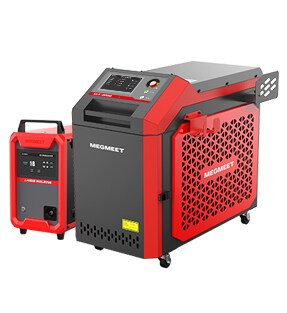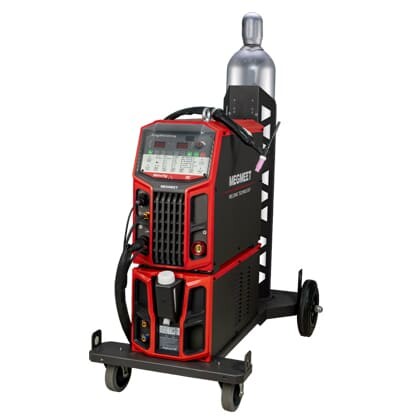Welding is a process of joining two or more pieces of metal or plastic by applying heat, pressure, or both. There are many types of welding methods, each with its own advantages and disadvantages. In this article, Megmeet will compare and contrast two popular welding methods: laser welding and TIG welding.
I. What is Laser Welding?
Laser welding is a welding method that uses a laser beam to melt and fuse the materials at the joint. A laser beam is a concentrated and coherent beam of light that can generate high temperatures and power. Laser welding can be done in two modes: heat conduction mode and keyhole mode.

Heat conduction mode is when the laser beam heats the surface of the material to its melting point but does not vaporize it. The molten material flows and solidifies to form a smooth and clean weld.
Keyhole mode is when the laser beam penetrates the material and creates a small hole or cavity filled with vaporized material. The vapor pressure inside the hole prevents the molten material from collapsing, creating a deep and narrow weld. As the laser beam moves along the joint, the hole follows it, leaving behind a solidified weld seam.
II. What is TIG Welding?
TIG welding is a welding method that uses an electric arc to create a weld. TIG stands for tungsten inert gas, which refers to the components of the welding system. A tungsten electrode is used to generate an electric arc between the electrode and the workpiece. An inert gas, usually argon, is used to shield the arc and the weld pool from atmospheric contamination. A filler metal, usually a thin wire, is used to add material to the joint. TIG welding can be done in two modes: autogenous mode and filler mode.

Autogenous mode is when no filler metal is used, and the weld is formed by melting and fusing the base materials only.
Filler mode is when a filler metal is used, and the weld is formed by melting and fusing both the base materials and the filler metal.
III. Differences Between Laser Welding and TIG Welding.
Laser welding and TIG welding have some similarities and differences in terms of their features, applications, advantages, and disadvantages. Here are some of them:
Speed: Laser welding is faster than TIG welding, as it can achieve high welding speeds up to several meters per minute. TIG welding is slower than laser welding, as it requires more manual control and skill.
Quality: Laser welding can produce high-quality welds with minimal distortion and heat-affected zones. Laser welding can also create narrow, deep, and smooth welds with precise control. TIG welding can also produce high-quality welds with good appearance and strength. However, TIG welding can cause more distortion and heat-affected zones than laser welding.
Flexibility: TIG welding is more flexible than laser welding, as it can weld different types of materials, such as metals or plastics, with different melting points and thicknesses. TIG welding can also weld complex shapes and hard-to-reach areas with ease. Laser welding is less flexible than TIG welding, as it requires more preparation and alignment of the workpieces. Laser welding can also be affected by factors such as reflectivity, absorption, thermal conductivity, and surface condition of the materials.
Automation: Laser welding is more suitable for automation than TIG welding, as it can be easily integrated with robots or other automation systems for enhanced efficiency and accuracy. Laser welding can also be combined with other processes, such as cutting or marking, in one machine. TIG welding is less suitable for automation than laser welding, as it requires more human intervention and skill.
Cost: Laser welding is more expensive than TIG welding, as it requires special equipment and maintenance. Laser welding also consumes more energy than TIG welding. TIG welding is cheaper than laser welding, as it requires less equipment and maintenance. TIG welding also consumes less energy than laser welding.
IV. Conclusion
Laser welding and TIG welding are two different methods used to join two materials together. While both methods are effective, they each have their own pros and cons depending on the application and requirements. Laser welding is faster, higher quality, and more automated, but more expensive and less flexible than TIG welding. TIG welding is slower, lower quality, less automated, but cheaper and more flexible than laser welding. Therefore, the choice of the best welding method depends on factors such as the type and thickness of the materials, the shape and size of the joint, the speed and accuracy of the process, the cost and maintenance of the equipment, and the skill and safety of the operator. By understanding the differences between laser welding and TIG welding, you can select the most suitable welding solution for your needs.
Megmeet is one of the best welding machine manufacturers in China and has been engaged in the R&D and manufacturing of MIG/MAG/TIG/MMA and laser welding machines for a long time, so you give 100% trust to Megmeet. If you want to know more about Megmeet Welding Technology or Megmeet welding solutions, you can contact us now
Related articles:
1. Laser Welding vs TIG Welding - What’s the Difference
2. What is Hybrid Laser-Arc Welding and How Does It Work?
3. What protective gas should I use for laser welding?
4. Fiber Laser Welding: Advantages, Systems and Applications
5. Spot Size, Laser Quality and Welding Performance





